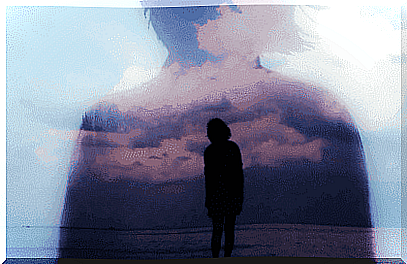Learn To Understand The Language Of Depression

The language of depression has a voice that makes you change. Anxiety, indifference and despair seep into the words you use. Your language pattern also changes. Everything becomes more short-sighted and gloomy, and the driving force is a deep bitterness that distorts reality.
Depression manifests itself in many different ways in our lives. The worst prank it plays on us, however, is that it distorts everything. It changes our behavior, our motivation, our habits, our thoughts and our language. Sometimes the effect is that, instead of responding to depression, we begin to assimilate it and its dark presence as part of ourselves.
We make this statement for very obvious reasons. Some people try to normalize these helpless attitudes. Depressed people are barely able to fulfill their obligations and responsibilities, but no one notices how they are followed by a shadow. In this regard, we have new technology that uses social media to identify linguistic patterns related to depression. The results reflect the high depression rates in our society.
The University of Texas conducted a study to detect signals of depression in human interactions via social networks and Internet forums. Our teenagers tend to e.g. to use these platforms to air and communicate their thoughts. It is worrying to discover these clear signs of psychological disorders in people who often do not receive any help. How is this possible? Because no one became aware of their disturbances.
Remember that depression leaves its mark. There are clues that testify to depression in the way we communicate. Let’s take a deeper look at the language of depression .

The language of depression is part of our culture. This may surprise you, but it actually is. There are lots of songs that reveal the mood of a musician who is in a dark and complicated phase of life. Artists like Kurt Cobain and Amy Winehouse are excellent examples of that type. We love their lyrics because we love sad songs and stories.
We find more examples of this in theater, literature, film art and poetry. Sylvia Plath, a well-known poet, said: “Dying is an art like anything else. I’m doing exceptionally well. ” Virginia Woolf left a lot of obvious and sometimes brutal clues in many of her books, for example in The Waves and Mrs. Dalloway.
Sometimes these disorders can lead to creative geniuses (as in the above cases). It’s almost like making a pact with the devil, for success, recognition and creative skill often come at the cost of the artists dying.
You usually guess what will happen. Their works are filled with hints of their imminent, desperate and gloomy end. For the language of depression is bitter and has patterns that are easy to recognize. It is a mirror that reflects the language user’s stormy inner life.
Let us try to learn to identify the language of depression.
Earlier this year, the journal Clinical Psychological Science reported on a way to detect depression through language. And here we are not just talking about oral communication. As we mentioned at the beginning, we now have technology that allows us to detect certain disturbances via social media.
- The first aspect of the language of depression that stands out is the content. Of course, negative emotions dominate. Despair, fatalistic thoughts and words like “loneliness”, “depression” and “fear” are common.
- There is also an abundance of absolutist expressions in the language of depression. People write things like “There is no solution”, “I have no hope”, “Tomorrow does not exist”, “I am always alone” or “No one understands me”.
It is important to mention that experts associate this kind of expression with people who have suicidal thoughts.

Another characteristic of this kind of language is that it uses almost exclusively the pronoun “I”. For a depressed soul, the world becomes very small, narrow and depressing. This suffering holds only one person. This “I” can no longer relate to other people and can not see situations from other points of view. The person has lost his ability to have compassion, to put perspective on life or to be open to more optimistic thoughts.
This way of constantly speaking in the first person is another sign that the negative emotions are overwhelming.
The language reflects your thoughts and your mood. So when a depression has dominion over you, this leads you to dwell on your obsessions. This recurring habit is like stagnant water. Nothing new is added, just the same old information that goes in circles and gnaws until you feel bad.
Therefore, you often hear that a depressed person takes up the same topic over and over again. They get stuck in certain conversations, negative ideas, doubts and obsessions. Asking them to stop or change the subject is pointless. It is simply impossible for them to do so.

The good thing about understanding the language of depression is that you can intercept the first signals from your loved ones and try to intervene. This is important for so many of us, especially for those who have children and teenagers.
Some people believe that certain behaviors and communication styles can be explained by a normal rebellious teenage phase. But this dynamic and these expressions do not correspond to a particular personality type. Instead, they often indicate a psychological disorder. Depression is becoming more common and to try to prevent it, it is important to know how to react.







